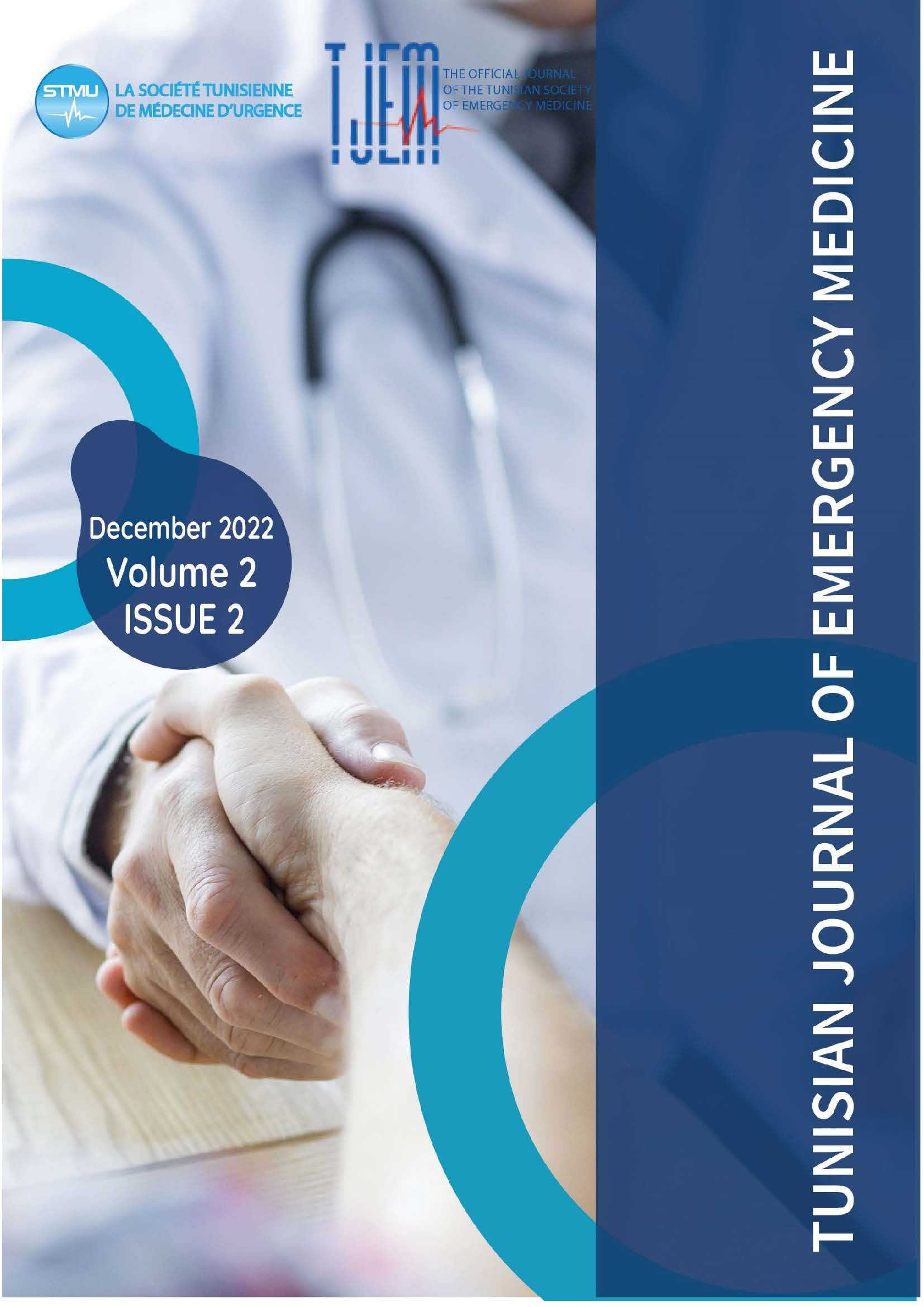Evaluation of the prescription of additional examinations in emergency departments
DOI:
https://doi.org/10.0000/270fs198Keywords:
Complimentary tests, Blood tests, Imaging, Evaluation, Emergency department, ManagementAbstract
Objectives: This study aimed to describe the state of play of the prescription of additional examinations in the emergency department and to analyze the contribution of additional examinations in the treatment of acute pathologies, as well as the benefit of their prescription.
Methods: Prospective study including patients in the emergency department. A standardized questionnaire was completed by the clinician (resident, resident, or senior doctor) responsible for the initial management of the patient.
Results: 179 patients including 42.4% men and 57.6% women were included in our study, additional examinations were carried out on 144 patients; 80.4% of the population; 728 examinations. 494 examinations were biological (67.85%), 105 radiological examinations (14.42%) and 129 other types (17.73%). 68.7% of these exams were prescribed by interns, 29.6% by residents, and only 1.7% by seniors who were only notified in 48% of cases.
Among the additional examinations requested, 61.03% of the biological examinations were of little or no contribution to the diagnosis and therefore inappropriate.
We found that 30.8% of the radiological examinations requested were of little or no contribution to the diagnosis and therefore inappropriate, among the most incriminated are Abdominal X-rays in 100% of cases and X-rays of the urinary tract. 78.8% of the diagnoses made after the complementary examinations agree with the initial hypothesis
diagnosis at the end of the clinical examination. To improve the behavior of the doctors prescribing these additional examinations and to reduce abuse, it is necessary to have good training of the doctors on the recommendations and the diagnostic value added by the additional examinations as well as the establishment of the protocol of prescriptions.
Overall residence time is also considered to be the key parameter for clinical progress and operational efficiency and explains the congestion in the emergency department. During our study, the ORT was 10 min to 1540 min with an average length of stay (ALS) estimated at 61 min without additional examinations and 3 h 33 min with a request for additional examinations.
One of the main causes of the delay in recovering additional examinations is the lack of coordination and management of the various health personnel, doctors, nurses, and stretcher-bearers.
Conclusion: Despite the existence of recommendations, a large number of additional examinations are unnecessarily prescribed to emergency departments. These prescriptions are responsible for an increase in the time and cost of treatment.
Downloads
Published
Issue
Section
License
Copyright (c) 2022 Tunisian Journal of Emergency Medicine

This work is licensed under a Creative Commons Attribution-NonCommercial-ShareAlike 4.0 International License.
How to Cite
Similar Articles
- Amira Sghaier, Marwa Toumia, Khaoula Bel Haj Ali, Adel Sekma, Kaouthar Beltaief, Zied Mezgar, Wahid Bouida, Riadh Boukef, Jamel Saad, Hamdi Boubaker, Mohamed Amine Msolli, Mohamed Habib Grissa, Semir Nouira, B-lines Ultrasonography Assessment by Nurses for the Diagnosis of Heart Failure in the Emergency Department , Tunisian Journal of Emergency Medicine: Vol. 2 No. 4 (2024): TJEM Vol2 Issue4
- Neila MAAROUFI, Firas Kessentini, Sabra Ouaz, Meriem Jemili, Moufida Nouari, Jihen Lakhal, Bilateral ptosis caused by midbrain hemorrhage: a case report , Tunisian Journal of Emergency Medicine: Vol. 3 No. 1 (2025): TJEM 2025: Vol.3 Issue 1
- Lassaad CHTOUROU, Jejunal Diverticulosis: Review , Tunisian Journal of Emergency Medicine: Vol. 2 No. 4 (2024): TJEM Vol2 Issue4
- randa dhaoui, A complicated pulmonary hydatid cyst mimickingpneumonia: A case report , Tunisian Journal of Emergency Medicine: Vol. 2 No. 4 (2024): TJEM Vol2 Issue4
- Samia Meherzi, Rihab Omri, Amin khbou , Rabiaa Kaddechi , Afifa CHARFI, Management of Bell palsy: our clinical practice guideline , Tunisian Journal of Emergency Medicine: Vol. 3 No. 1 (2025): TJEM 2025: Vol.3 Issue 1
- Faten DHOUIB, Aimen Dammak, Faiza Safi, Fatma MHIRI, zied CHAARI, Successful Conservative Management of Penetrating Cervical Tracheal Injury: A Case Report , Tunisian Journal of Emergency Medicine: Vol. 3 No. 1 (2025): TJEM 2025: Vol.3 Issue 1
- Fatma Hbaieb, Low Back Pain Revealing Bilateral ProximalPulmonary Embolism with COVID-19 , Tunisian Journal of Emergency Medicine: Vol. 2 No. 4 (2024): TJEM Vol2 Issue4
- Randa dhaoui, Khaoula bel Haj Ali, Adel Sekma, Sarra Sassi , Wahid Bouida, semir nouira, The challenge in diagnosing human rabies: A case report , Tunisian Journal of Emergency Medicine: Vol. 3 No. 1 (2025): TJEM 2025: Vol.3 Issue 1
- safia othmani, Ischemic acute cholecystitis: a case report , Tunisian Journal of Emergency Medicine: Vol. 2 No. 4 (2024): TJEM Vol2 Issue4
- Sirine Bouzid, Rim Karray, Amine Abdelhedi, Fadhila Issaoui, Olfa Chakroun, Noureddine Rekik, MULTIVISCERAL DAMAGE FOLLOWING ACUTE METHOTREXATE INTOXICATION BY DOSING ERROR , Tunisian Journal of Emergency Medicine: Vol. 3 No. 1 (2025): TJEM 2025: Vol.3 Issue 1
You may also start an advanced similarity search for this article.
Most read articles by the same author(s)
- Houda BEN SOLTANE, Predicting diabetic ketoacidosis severity score: proposal of a therapeutic strategy adapted to emergency department , Tunisian Journal of Emergency Medicine: Vol. 2 No. 3 (2023): TJEM Vol2 Issue3
- Houda BEN SOLTANE, A total volvulus of the small intestine on malrotation A total volvulus of the small intestine on malrotation A total volvulus of the small intestine on malrotation A total volvulus of the small intestine on malrotation A total volvulus of the small intes , Tunisian Journal of Emergency Medicine: Vol. 2 No. 3 (2023): TJEM Vol2 Issue3
- Houda BEN SOLTANE, Neurologic manifestations of infective endocarditis , Tunisian Journal of Emergency Medicine: Vol. 2 No. 3 (2023): TJEM Vol2 Issue3
- Houda BEN SOLTANE, Predicting diabetic ketoacidosis severity score: proposal of a therapeutic strategy adapted to the emergency department , Tunisian Journal of Emergency Medicine: Vol. 2 No. 2 (2022): TJEM Vol2 Issue2

